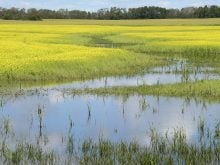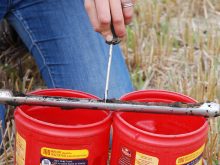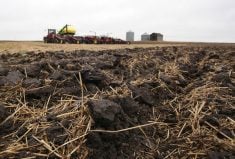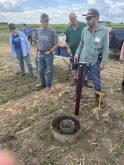Nearly two dozen counties in Montana have problems with acidic soils and a few farmers in the state have bought lime spreaders to increase the pH of their soils.
“(They) growers have seen tremendous yield losses due to acidity and spreading lime has shown great benefits,” said Manbir Rakkar, an assistant research professor in Land Resources and Environmental Sciences at Montana State University.
“Montana growers have spent (about) $55,000 to purchase lime spreaders, showing they take it seriously.”
That sort of expenditure isn’t commonplace, but many farmers across Montana are worried about acidic soils and researchers are keeping a close eye on the problem.
Read Also

Research looks to control flea beetles with RNAi
A Vancouver agri-tech company wants to give canola growers another weapon in the never-ending battle against flea beetles.
“Montana State University soil scientists… crop advisers, and producers have now identified fields in 23 Montana counties with locations where the top zero to six inches of soil have pH below 5.5, some as low as 3.8,” says a Montana State University website.
A number of those counties are next to Montana’s border with Canada. So, it’s possible that acidic soils are also a problem in southern Alberta.
But few farmers or soil scientists in Alberta are paying attention, says a retired agronomy research scientist with Alberta Agriculture.
Ross McKenzie is worried that low pH soils could soon become a major headache for prairie farmers. That’s because the same factors that cause acidic soils, zero tillage and increased use of nitrogen fertilizer are also present in Alberta.
“I’ve been retired for nine years, it’s something we’ve been pointing out that people need to be (studying),” McKenzie said a few days before Christmas. “It’s not something that (anyone) is working on…. It’s an issue right now and it’s gradually going to become a greater problem.”
Decades ago, experts from Alberta Agriculture monitored the soil pH in the grey soils of northern Alberta, which are naturally more acidic than brown and black soils.
That research and recommendations about managing low pH soils eventually faded away.
“Since 2000, there really hasn’t been any significant work on acid soils,” McKenzie said from his home in Lethbridge.
However, over the last 25 to 30 years, with the shift to reduced tillage and increased rates of nitrogen fertilizer, the soils in Alberta and other parts of the Prairies have likely become more acidic.
“Really it’s a concern for farmers across Western Canada, in my opinion,” McKenzie said.
“It’s really a matter of watching your soil pH levels. Once you see they’re at six or less… the more concerned you should be… Once you’re dropping below 5.5 then you have to take things more seriously.”
Sometimes, farmers forget that pH is a logarithmic scale, meaning that a pH of six is 10 times more acidic than seven.
“(And) a pH of five is 100 times more acidic than a pH of seven,” McKenzie said, which means it can take a long time to get soils back to neutral.


















